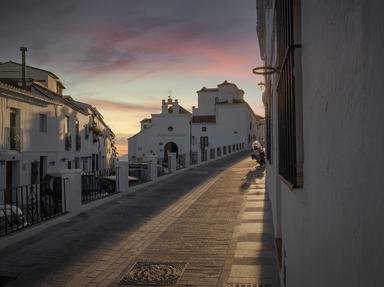Quiz Answer Key and Fun Facts
1. After touching down in Madrid, we head north toward the coast. On the way we reach Spain's most famous wine appellation. What is the name of these red wines which come from the sub-regions of Alavesi, Alta, and Baja?
2. In Bilbao, the largest city of the Basque region, we are driving down the Calle de Iparraguirre, and we see in front of us a huge silvery building guarded by a huge topiary dog covered in flowers. What are we dealing with here?
3. We drive along the lush green coast to the capital of the province of Navarre, Iruna, better known as Pamplona. This is the city famous for the annual "running of the bulls" in July. In which Ernest Hemingway novel was this event first immortalized?
4. As the travel resumes, we come to another of the myriad of famous sites in Spain, that of Santiago de Compostela, in the northwest corner of the country. What is its claim to fame?
5. Identify our next destination from the description: We head south from Santiago de Compostela and reach a famous town captured by Hannibal in 217 B.C., with a famous university founded in 1218, and which is notable for the golden stone used for building, it's Plateresque and Renaissance architecture. It is home to the "double" cathedral, with the 16th century church built directly next to the 12th century one. The 16th century Casa de las Conchas, or House of the Shells, covered with scalloped shells, currently houses the library.
6. Once again we must leave a magical place, but more delights await. On we go into Extremadura," , the least "touristy" province of Spain, but was it great! At night, the sky was so clear the heavens were filled with stars from horizon to horizon. What famous Extramaduran monastery has a caribbean island named after it and was the site of baptism of Caribbean natives brought back by Columbus in 1496?
7. We head back northeast. Identify the next city we visit by the following: The highest altitude provincial capital in the country, the town is encircled by the best-preserved medieval walls in Europe, with 88 towers, and is known for the many storks which inhabit the town. The cathedral has the tomb of a bishop referred to as "the tanned one" or in Spanish "El Tostado".
8. Our next destination is the famous El Escorial, the massive palace and monastery built between 1563 and 1584. This stark, imposing, gray building with 2600 windows and 1200 doors required 1500 workmen to complete. Which royal family constructed and lived in regal splendor in this palace?
9. For the last time, we swing south of Madrid into the province of windmills, cheese, marzipan, and saffron. Where are we?
10. Back in Madrid before we leave, we take a taxi to see the sights. Our taxi driver leisurely stops in the middle of our ride, turns off the meter and hops into the bakery to buy some bread for his dinner. Once we resume our ride, we end up at Madrid's most famous art gallery. What is its name?
Source: Author
jstagamtome
This quiz was reviewed by FunTrivia editor
minch before going online.
Any errors found in FunTrivia content are routinely corrected through our feedback system.

